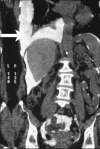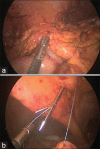Minimally invasive surgery for salvage of malfunctioning peritoneal dialysis catheters
- PMID: 29483375
- PMCID: PMC6293686
- DOI: 10.4103/jmas.JMAS_184_17
Minimally invasive surgery for salvage of malfunctioning peritoneal dialysis catheters
Abstract
Background: Malfunction of continuous ambulatory peritoneal dialysis (CAPD) catheters is a frequent complication and has traditionally been treated with a laparotomy. We present our experience with minimally invasive surgical (laparoscopic and thoracoscopic) salvage of CAPD catheters.
Materials and methods: Between October 2003 and June 2013, 19 patients (13 males and 6 females with a mean age of 37 years [range 28-64]) underwent minimally invasive laparoscopic salvage of malfunctioning CAPD catheters. These catheters had been placed with either a percutaneous or open technique and had been in place for a mean of 4.5 months (range 2-18 months). All the salvage procedures were performed under general anaesthesia using one 10 mm and two or three 5 mm ports. The various manoeuvres undertaken to re-establish catheter function included correct positioning the catheter and anchoring it to the pelvic peritoneum, clearing the fibrin clot/sheath, freeing up the omentum/bowel/taenia coli. In addition, all patients underwent an omentopexy.
Results: Laparoscopic salvage could be completed in 18 patients with good catheter inflow and outflow established at the end of the surgery and one patient underwent thoracoscopic salvage. The median operative time was 63 min (range 45-96 min) and median post-operative hospital stay was 2 days (range 2-5 days). Low volume dialysis was commenced the day after surgery and full volume dialysis by the 10th day. There were no intra- or post-operative complications. All the catheters were functioning at the end of 6-month follow-up.
Conclusions: Minimally invasive surgery is a valid, safe and efficacious way of salvaging malfunctioning CAPD catheters. This modality reduces the chances of re-formation of adhesions, ensures rapid recovery, reduced wound-related complications and allows for early institution of peritoneal dialysis.
Keywords: Continuous ambulatory peritoneal dialysis; continuous ambulatory peritoneal dialysis catheter; laparoscopy; peritoneal dialysis; salvage.
Conflict of interest statement
There are no conflicts of interest
Figures




Similar articles
-
Laparoscopic omentectomy for salvage of peritoneal dialysis catheters.J Endourol. 2002 May;16(4):241-4. doi: 10.1089/089277902753752214. J Endourol. 2002. PMID: 12042108
-
Laparoscopic management of malfunctioning peritoneal dialysis catheters.Oman Med J. 2011 May;26(3):171-4. doi: 10.5001/omj.2011.41. Oman Med J. 2011. PMID: 22043409 Free PMC article.
-
Laparoscopic omental fixation technique versus open surgical placement of peritoneal dialysis catheters.Surg Endosc. 2003 Nov;17(11):1749-55. doi: 10.1007/s00464-002-8586-3. Epub 2003 Jun 19. Surg Endosc. 2003. PMID: 12811666
-
Malfunctioning peritoneal dialysis catheter and accompanying surgical pathology repaired by laparoscopic surgery.Perit Dial Int. 2002 Jul-Aug;22(4):454-62. Perit Dial Int. 2002. PMID: 12322816 Review.
-
Dialysate leaks in peritoneal dialysis.Semin Dial. 2001 Jan-Feb;14(1):50-4. doi: 10.1046/j.1525-139x.2001.00014.x. Semin Dial. 2001. PMID: 11208040 Review.
Cited by
-
Intra-Abdominal Adhesions and Peritoneal Dialysis: A Challenge, Not a Contraindication.Clin J Am Soc Nephrol. 2024 Apr 1;19(4):412-414. doi: 10.2215/CJN.0000000000000447. Clin J Am Soc Nephrol. 2024. PMID: 38598195 Free PMC article. No abstract available.
-
Does Laparoscopic Omentectomy Reduce CAPD Catheter Malfunction: A Three-arm Pilot Randomized Trial.Indian J Nephrol. 2022 Jul-Aug;32(4):299-306. doi: 10.4103/ijn.ijn_168_21. Epub 2022 May 20. Indian J Nephrol. 2022. PMID: 35967525 Free PMC article.
-
SAGES peritoneal dialysis access guideline update 2023.Surg Endosc. 2024 Jan;38(1):1-23. doi: 10.1007/s00464-023-10550-8. Epub 2023 Nov 21. Surg Endosc. 2024. PMID: 37989887
References
-
- Kimmelstiel FM, Miller RE, Molinelli BM, Lorch JA. Laparoscopic management of peritoneal dialysis catheters. Surg Gynecol Obstet. 1993;176:565–70. - PubMed
-
- Velasco García MA, García Ureña MA, Carnero F, Fernández Ruiz E, Remón Rodríguez C, Aljama Pérez-de-Lastra P, et al. Omental entrapping of the peritoneal dialysis catheter solved by a laparoscopic approach. Perit Dial Int. 1997;17:194–5. - PubMed
-
- Chao SH, Tsai TJ. Laparoscopic rescue of dysfunctional Tenckhoff catheters in continuous ambulatory peritoneal dialysis patients. Nephron. 1993;65:157–8. - PubMed
-
- Brandt CP, Ricanati ES. Use of laparoscopy in the management of malfunctioning peritoneal dialysis catheters. In: Khanna R, editor. Advances in Peritoneal Dialysis. Vol. 12. Toronto: Peritoneal Dialysis Publications; 1996. pp. 223–36. - PubMed
-
- Smith DW, Rankin RA. Value of peritoneoscopy for nonfunctioning continuous ambulatory peritoneal dialysis catheters. Gastrointest Endosc. 1989;35:90–2. - PubMed
LinkOut - more resources
Full Text Sources
Other Literature Sources
